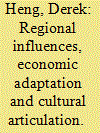| Srl | Item |
| 1 |
ID:
112483


|
|
|
|
|
| Publication |
2012.
|
| Summary/Abstract |
Colonial transformation of the relations of production contextualized the cultural articulation of a new set of values, prejudices, and tastes for the Bengali Hindu middle class. These cultural values, together with the political and economic conditions of colonialism, formed the habitus of this class. This paper tries to understand this self-fashioning by the middle class through their construction of a 'Bengali' cuisine. A distinct enthusiasm for new gastronomic possibilities defined this cuisine, and yet, at the same time, it possessed important elements of continuity from pre-colonial times, evidenced especially in the reinstitution of caste-based norms of gastronomy. The resultant cuisine was cosmopolitan yet still Bengali.
|
|
|
|
|
|
|
|
|
|
|
|
|
|
|
|
| 2 |
ID:
173378


|
|
|
|
|
| Summary/Abstract |
Studies on the international history of fourteenth-century Singapore have been hitherto limited to external trade conducted by local inhabitants, and material consumption patterns that this trade enabled them to develop. Broader regional cultural influences have been postulated though not clearly demonstrated, given scant textual records and limited material culture remains. This article seeks to examine the external influences, adaptation and assimilation in the production and consumption of fourteenth-century Singapore. In particular, it looks at three aspects of Singapore's pre-colonial existence — modes of economic production, patterns of consumption of international products, and the articulation of high culture vis-à-vis external entities. By examining available archaeological, epigraphic, art historical and cartographic data from the fourteenth through the nineteenth centuries, this article postulates how distinct consumption patterns may have developed among different riverside populations living north of the Singapore River. This study also questions the common view that Singapore developed as a cosmopolitan port-city only after the advent of British colonialism, demonstrating that its diversity and openness was likely a feature centuries before.
|
|
|
|
|
|
|
|
|
|
|
|
|
|
|
|